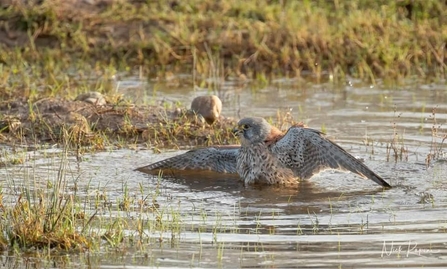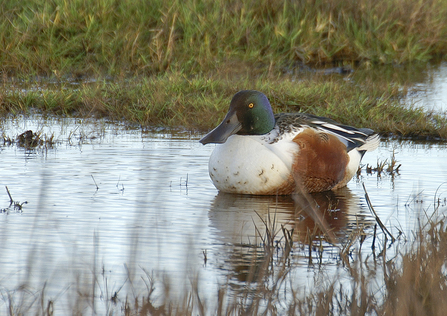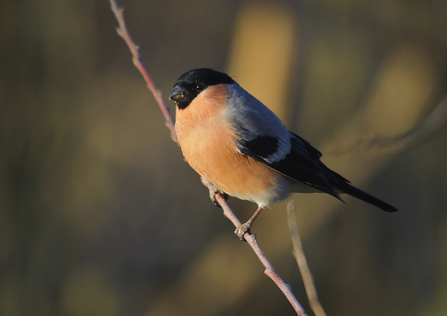From breeding displays to freshly-bloomed flowers, there were so many exciting natural spectacles to see in February.
Latest wildlife sightings – February 2021

Kestrel bathing at Brockholes by Nick Raponi
Brockholes
In January the reserve was a winter wonderland, but last month Brockholes began turning into a spring wonderland, with signs of spring all around. Song thrushes were bursting into song right across the reserve, snowdrops and willow catkins emerged to delight visitors and buzzards provided a real spectacle with their airborne courtship displays. The stonechats that showed so beautifully for us all winter started disappearing back to the upland haunts where they prefer to spend the warmer months, and crowds of goldeneye were spotted swimming down the Ribble. Excitingly, the first frogspawn was recorded in Boilton Wood on 28 February!
It was lovely to see Brockholes’ barn owls so active last month, with them regularly seen quartering the marsh. The sunnier days cast a wonderful light onto the lapwings’ feathers and showed why they’re also known as ‘green plovers’, with the sunlight bringing out their beautiful petrol sheen. Kevin the kestrel wasn’t about to let them steal the show though – he was photographed taking a very public bath in a puddle!
Mere Sands Wood
February was all peace and tranquillity at Mere Sands Wood. A handful of male goosanders joined the ducks on the lakes and kingfishers were spotted hunting unsuspecting fish. Snowdrops started popping up the woods where blue tits, treecreepers and nuthatches were busy filling up at the feeding stations. With breeding season well on the way they’ll need all the energy they can get.

Male shoveler by David Longshaw
Middleton Nature Reserve
The snow and ice we faced earlier in February saw huge numbers of gulls squeezing onto the one ice-free area of the main pond. More than 100 gulls, in fact! There was also plenty to see on the other ponds and pools around the reserve, with gadwall, shovelers, little grebes, grey herons and teal all dabbling, diving and hunting. With spring approaching, the Cetti’s warblers started calling louder and more frequently, and it was lovely to see a woodcock on the western marsh.
Heysham harbour
February is a funny month on the Heysham coast, teetering between the heights of migratory bird action and the great spring shift. The ‘usual suspects’ busied themselves with feeding and roosting around the area, but it’s this familiar hum of activity that we think makes Heysham so special at this time of year. There is always something lovely to see.
The skeer saw the main buzz of activity, with large groups of eider ducks coming quite close to shore and displaying wonderfully; making their comedic calls. Red-breasted mergansers were sighted regularly, as well as turnstones and, of course, knot, with around 2,000 counted in a single afternoon. Pale-bellied Brent geese were still guzzling seagrass, with a high-count of 24 around mid-February.
There lots of great wildlife sightings around Red Nab, too. Cormorants, shelducks, wigeon, grey herons and little egrets were joined by osytercatchers, lapwings, curlews, ringed plovers and redshank. Snipe were seen regularly on the saltmarsh and a merlin and peregrine falcons were still hassling the dunlin.
However, one of the most interesting wildlife sightings involved a bird most people wouldn’t even look twice at, and another interesting sighting, not a bird at all. The first was a crow demonstrating the immense intelligence shared by the entire corvid family – it was opening mussels by flying into the air and dropping them onto a hard surface, in this case the pavement. The second sighting was of the seal photographers have regularly snapped feeding in the outflows, or should we say, three seals. Local photographer, Janet Packham, was watching them regularly and identified that their markings singled them out as three distinct individuals, with confirmation from Walney nature reserve.

Male bullfinch by John Bridges
Heysham Nature Reserve
It was nice to see new life emerging at Heysham Nature Reserve, with the first butterfly spotted on 26 February. It was a small tortoiseshell – always one of the first to emerge – and we don’t think it’ll be long before brimstones come out to join them.
Bullfinches have also been showing well at the reserve, with the still-bare trees letting visitors get a good look at their stunning plumage: a bright coral in the males and dusky peach in the females.
Chat Moss
It’s official – February saw lapwings flocking back to our peatlands for the breeding season. This means it’s more important than ever to stick to the footpaths and keep dogs on leads if you visit any area of Chat Moss (or any other wild place) for your daily local walks. Lapwings and many other animals (including deer, hares and curlews) live their life at ground level; roosting, feeding and nesting on the ground.
Just as thrilling as the influx of lapwings was a willow tit sighting at Astley Moss! Willow tits are England’s fastest declining bird species and we’ve been working hard to create their perfect wet woodland habitat at the fringes of our peatlands. Project Officer, Jamie, spotted our first willow tit and was beside himself with excitement.
With spring well and truly on the way, we can’t wait to see what the next month of wildlife sightings brings to Lancashire, Manchester and North Merseyside. If one of our nature reserves makes up your local walk, we’d love to see what you spot as the seasons change. Click one of the icons below to share your sightings with us on Facebook, Twitter or Instagram.

